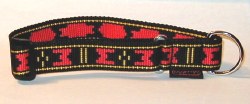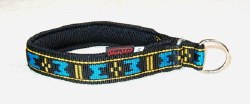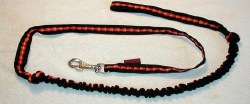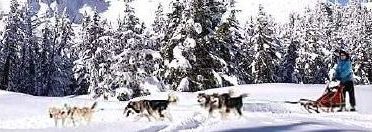If you're looking for an Alaskan Malamute puppy, the breeders of Snowlion Alaskan Malamutes, located in California, can help you pick out the perfect family companion, show dog or sled dog. We are one of the top Alaskan malamute breeders, known throughout California, the U.S., Europe, Canada, and Australia, for producing beautiful Alaskan Malamute champions including several outstanding red alaskan malamutes and the well-known Best in Show red alaskan malamute, Ch Snowlion's Soldier of Fortune. The alaskan malamutes currently at Snowlion Kennels reflect a repeated crossing of three unrelated blood lines traced back to the foundation dogs we started with in the 1990s. Many of our pedigrees reflect line breedings on BISS Ch Nanuke a Rumor of War "Charlie," as well as our main core--malamutes of Rmal/Skyfyre Kennels including Ch Snowlion Kali Devi WLD and Ch Rmal Snowlion Mystik Zzombe WLD, and Uyak Aleut Alex. Snowlion Alaskan Malamutes, AKC champions and family companions have gone to Australia, Asia, Canada, Europe, Mexico and through out the U.S. However, since the start of the pandemic we are no longer shipping any dogs internationally.
Handling your Alaskan Malamute Puppy
Handle young puppies carefully and gently as their joints, bones and ligaments are not fully developed and can be injured until the growth plates close between 9-12 months.
Do not let older or larger dogs play roughly with the pups. Avoid letting your pup run up
and down stairs or on slippery surfaces. Torn muscles in shoulder or groin are common injuries and take a long time to heal.
Children love to play with pups but make sure the pup
doesn't get dropped. Insist that young children sit down on the floor
when handling pups. A squirmy pup can easily be dropped and injured. Please remember that young children should never be left unsupervised with dogs--any dogs.
How much exercise?
Malamutes like most large working breeds need lots of exercise. But puppies should not be run on a leash until they are over 6 months old. Young puppies under 6 months of age should be walked twice a day and allowed plenty of time outside to play off lead but no sustained jogging or running. We start walking our pups at 8 weeks gradually building up to one mile. Ideally, pups should be exercised on trails, dirt roads or grass to avoid the high impact of walking long distances on concrete or asphalt. During warmer months, exercise your malamute in the early morning or late evening. Carry water for your pup on longer hikes and make sure he doesn't overheat.
What about backpacking and weight-pulling?
Although we start our pups in harness by 9 months, they are running on a large team and not pulling any weight. Team running with 3 or 4 other dogs is fine, but please don't expect a young malamute to pull a loaded sled until they are close to 18 months. If your interest is backpacking, you can train the dog to carry a light pack by 1 year, but do not overload the pup. A fully grown and conditioned malamute can carry up to 30% of it's body weight. Be patient and allow your malamute pup to grow up before asking it to do too much. The risk of joint injury--to the shoulders, knees, elbows or hips is not worth the risk.
You can teach your young pup pulling and sledding commands while walking. We use a leash attached to the tug line (rear loop) of a padded harness and attach another leash to the collar. Encourage the pup to move out ahead of you in a straight line with no stops or wandering to the side. You can teach Gee and Haw turns. Whoa (stop) by applying gently pressure to the collar to guide each turn.
A few training tips
To start leash training the pup use a retractable 16 ft. leash and have someone walk in front of the puppy to guide him. It works well too, if the lead person walks another dog by his side. The young puppy has a natural instinct to follow. Alternate using a leash and no leash if you have a fenced area. Be sure there are no stray dogs or any traffic nearby. Teach the puppy to come to you by calling his name in a happy high-pitched voice. It helps to kneel down and get at his level. We carry a pocketfull of treats on all walks. Our dogs are repeatedly called back to us to reinforce our control when they are off-lead. Teaching a reliable recall or come is probably the most important thing you can do for your puppy to ensure his safety if he gets loose.
Training classes
We recommend finding a puppy socialization and basic training class specifically designed for young pups. These classes typically will allow pups to play off lead for a while and are safer than classes with 'problem' adult dogs. Ask your veterinarian, vet techs, groomer, pet store owners, neighbors and friends for recommended trainers. If possible observe one class and be sure you are comfortable with the instructor. Training should be fun for you and your pup! Make sure your pup has had at least 2 immunizations before starting class-- at 12 weeks. Most malamute trainers and breeders do NOT recommend dog parks for a number of reasons. Owners have no control over loose dogs and many are unaware of the posturing and underlying aggression until a scuffle breaks out. Malamutes are very social, hierarchy-conscious dogs. As pack animals malamutes have strict rules about acceptable greeting behavior and other breeds seem to be oblivious to basic canine etiquette involving submission, dominance, play and greeting. Malamutes do better with a group of 'regulars'-- familiar play mates. While pups may be okay in a dog park environment, once a malamute reaches sexual maturity the rules will change and they will be less tolerant of that rambunctious golden retriever that comes bounding up at 15 mph. Issues of space, posturing, and innappropriate canine behavior may trigger a defensive reaction by the malamute including a warning growl that may quickly escalate into a full-blown fight. We prefer careful and slow introductions between two dogs on very loose leads. This type of control is not available in a dog park environment. Please remember that malamutes by nature generally prefer dogs of the opposite sex unless they've been raised with them. This is a breed trait and you can not expect your malamute to behave like a lab or golden retriever. The temperament and innate behavior of this northern breed is different. Accept it and do not put your malamute in a no-win situation where he is likely to feel threatnened. For a young pup, under 6 months of age, an adjustable sledding collar is best. When the puppy is nearly full grown 11-12 months, we like to use a semi-slip padded sledding collar. Be sure and measure around the dog's neck to get the right size.
dogs. For leashes we use a pliable 6 ft leather lead and a medium-size flexi (retractable) lead. Howling dog mushing supplies also makes a nice bungee 6 ft leash and good quality collars. We also like their lightweight ManMat harnesses for sledding. Please don't hesitate to call us if you have a training question, we've been living with malamutes for nearly thirty years and have dealt with most training issues. Please remember the problem is not usually the dog's behavior--he is just acting like a dog--whether it's digging, barking, stealing food off counters, chewing. It is up to you to channel and manage these 'normal' dog traits. We are firm believers in using crates to avoid inappropriate chewing in the house and in cars. If your dog grabs food off the counters the solution is simple: keep him out of the kitchen or make sure no food is ever left out. You must manage your dog's environment so that he is not set up for 'failure.' Many'dog problems' are the result of leadership issues in the household; without boundaries and firm guidelines from his human pack leader, a dog will create his own set of rules.
There are hundreds of training books on the market. Three of my favorites which reflect most closely how we raise and live with our dogs: What about dog parks?
What kind of collar should I get?

Adjustable "standard collar"
best for young puppy 
Padded semi-slip (choke) collar
ideal for adult dog
Bungee leash
Lightweight but durable Your breeders are your best resource!
1. How to be Your Dog's Best Friend--2nd edition by The Monks of New Skete --also available on DVD
2. The Art of Raising a Puppy- by the Monks of New Skete
3. Beyond Obedience- by April Frost

